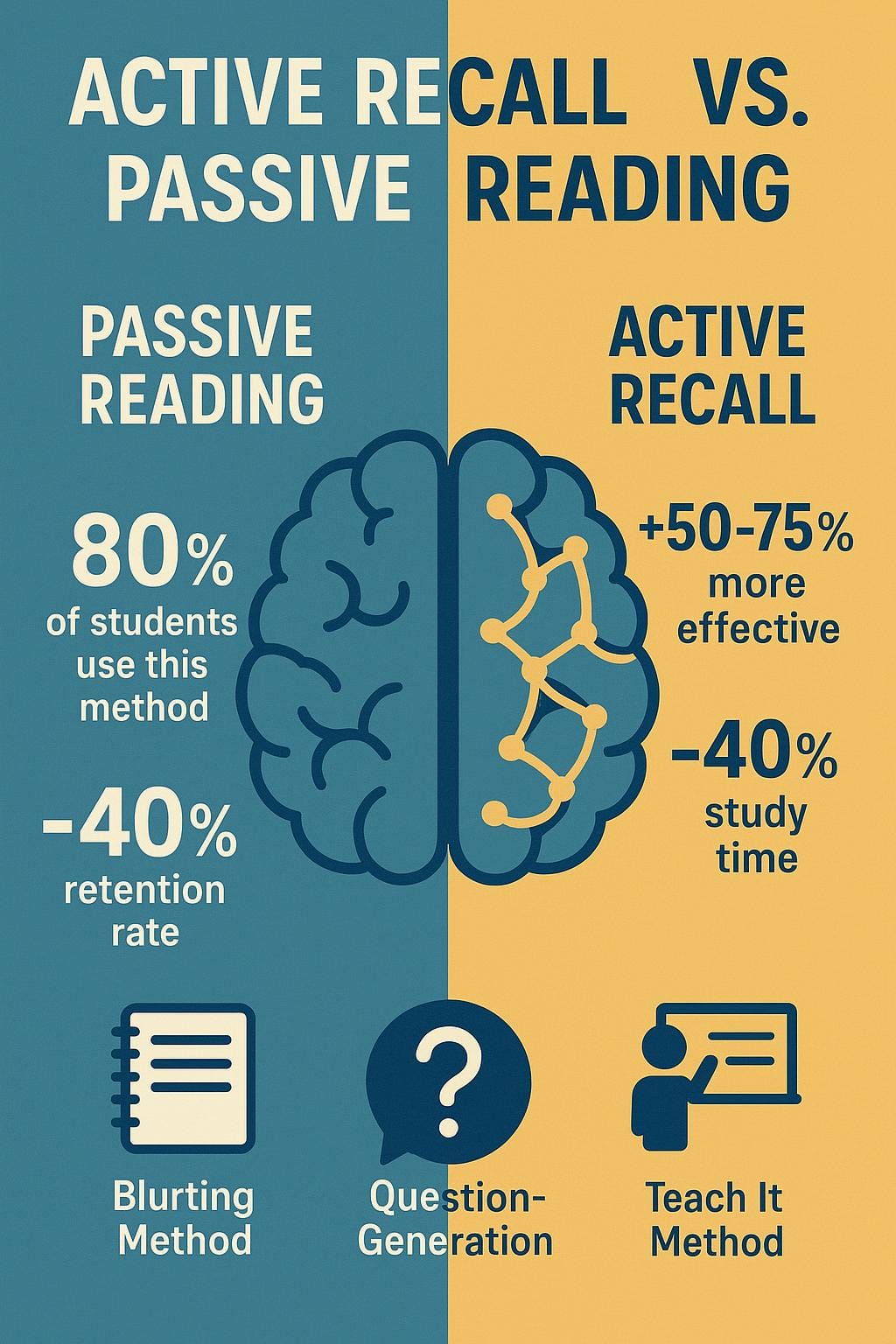Active recall transforms the way you study by requiring you to retrieve information from memory rather than passively reviewing it. Research shows this approach creates stronger neural connections, leading to better retention and understanding of material while simultaneously reducing the total time needed to effectively prepare for exams.
Key Takeaways
- Nearly 80% of students rely on passive re-reading despite evidence showing it creates a false sense of knowledge
- Active recall is 50-75% more effective than traditional study methods for long-term retention
- The “blurting method” forces your brain to retrieve information without cues, doubling retention rates compared to passive review
- Question generation and the Feynman Technique turn passive notes into active learning tools
- Using active recall can reduce total study time by 40% while improving test performance and reducing anxiety
The Illusion of Learning: Why Most Study Methods Fail
If you’re like most college students, your go-to study technique probably involves re-reading notes, highlighting textbooks, and reviewing PowerPoint slides. This approach creates what cognitive scientists call an “illusion of competence” – material looks familiar, so you believe you know it well.
Research reveals approximately 80% of students rely primarily on passive re-reading as their main study technique. The problem is that recognizing information is fundamentally different from being able to retrieve it independently during an exam.
This leads to the “labor-in-vain” effect – spending hours studying without proportional learning gains. You might dedicate entire weekends to reviewing material, only to blank on key concepts when facing exam questions.
The reason is simple: passive review doesn’t mirror what you’ll actually need to do during a test. When you’re taking an exam, no one is showing you the answers first – you need to pull them from memory.
Active Recall: The Science-Backed Alternative
Active recall flips traditional studying on its head by forcing your brain to retrieve information rather than simply recognize it. Think of passive reading as watching a cooking show, while active recall is actually being in the kitchen, trying the recipe yourself.
The science behind this approach is compelling. Research from Purdue University demonstrates that active recall is 50-75% more effective than re-reading for long-term retention. Each time you successfully retrieve information, your brain strengthens neural pathways associated with that knowledge.
This phenomenon, known as the retrieval practice effect, works with your brain’s natural learning mechanisms. When you struggle slightly to recall information, you create what researchers call “desirable difficulty” – a productive form of cognitive stress that enhances memory formation.
Unlike passive review, which often creates a false sense of mastery, active recall gives you honest feedback about what you actually know. This metacognitive awareness allows you to focus your limited study time on genuine knowledge gaps rather than material you’ve already mastered.
Three Powerful Active Recall Techniques
Let’s explore three evidence-based active recall methods you can implement immediately. These techniques require no special tools and can be adapted to any subject or course material.
The first technique is the “Blurting Method.” After reading a section of material, close your book or notes and write everything you can remember on a blank page. Then compare your “blurt” with the original material to identify knowledge gaps. Research shows this simple approach can double retention compared to re-reading.
Next is the Question-Generation Method. Instead of passively summarizing notes, transform them into potential test questions using stems like “Compare and contrast…”, “Explain how…”, or “What is the significance of…”. Create a bank of 25-30 questions per chapter, then systematically test yourself without looking at your notes. A Cornell study found students using this method scored 20% higher on exams.
The third technique is the “Teach It” Method, also known as the Feynman Technique. Select a challenging concept and pretend you’re explaining it to someone who has no background knowledge. If you can’t explain it clearly without referencing your notes, you’ve identified a critical gap in your understanding.
For maximum benefit, try recording yourself on your phone or finding a study buddy for reciprocal teaching. This approach forces you to organize information logically and express it in your own words – exactly what you’ll need to do on exams.
Your Midterm Action Plan: Study Less, Remember More
Integrating active recall into your existing study routine doesn’t require a complete overhaul. Research suggests aiming for a balance of 70% active recall and 30% initial content review.
Here’s a concrete weekly plan for midterm preparation:
- Monday-Thursday: Spend 30 minutes per day on active recall for each subject
- Friday: Review problem areas identified during active recall sessions
- Weekend: Conduct longer, comprehensive active recall sessions across multiple chapters
What about those moments when you get stuck during active recall? This is actually valuable information, not a failure. When you can’t retrieve something, note it specifically and make it a priority for focused review.
Perhaps the most surprising benefit is time efficiency. Studies show active recall can reduce total study time by approximately 40% while improving retention. This happens because you’re targeting exactly what you don’t know rather than wasting time reviewing material you’ve already mastered.
Students who switch to active recall also report lower pre-test anxiety. When you’ve repeatedly tested your knowledge before the exam, you develop justified confidence in your preparation. One case study followed students who switched to active recall mid-semester and saw grade improvements averaging 27% with less reported study time.
Making the Switch to Active Recall
Transitioning to active recall might feel uncomfortable at first. The method intentionally exposes knowledge gaps, which can initially feel discouraging compared to the false confidence of passive review.
Start small by applying active recall to a single topic or chapter. The immediate feedback will likely convince you of its effectiveness. Remember that struggling to recall information is not a sign of failure – it’s precisely this productive struggle that enhances learning.
Active recall is particularly powerful when combined with spaced repetition – increasing the intervals between practice sessions over time. This combination leverages two of the most evidence-based learning techniques in cognitive science.
The midterm method isn’t about studying more – it’s about studying smarter. By aligning your study techniques with how your brain actually learns, you can achieve better results with less time and stress. Your future self, confidently walking into exams with genuine mastery of the material, will thank you.
Sources
Learning Scientists – Six Strategies for Effective Learning
National Library of Medicine – Improving Students’ Learning With Effective Learning Techniques
SAGE Journals – Improving Classroom Performance by Using the Retrieval Practice Technique










